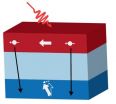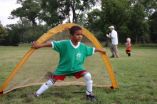(Press-News.org) A hard drive stores bits in the form of tiny magnetic domains. The directions of the magnetic north and south poles of these domains, which are referred to as the magnetization, determine whether they are a 0 or a 1. Data is stored by changing the direction of the magnetization of the associated bits. At present this is done using a write head to create a local magnetic field, which makes a bit change direction.
Limit reached
The stronger the local magnetic field, the faster the switch takes place. But this is subject to a limit which has now almost been reached. "The number of bits has been growing rapidly for many years, but the write speed has hardly increased. There's a need for a new data storage technology", says TU/e researcher Sjors Schellekens. He is the lead author of a publication in Nature Communications, in which together with colleagues he presents a new technology.
Magnetic stream
The physicists, led by TU/e professor prof.dr. Bert Koopmans, use a special property of electrons, the spin – a kind of internal compass in the electron. Using ultra-fast laser pulses they generate a flow of electrons in a material which all have the same spin. The resulting 'spin current' changes the magnetic properties of the material (see the figure for an explanation of the technology).
A thousand times faster
"The change in the magnetization is of the order of 100 femtoseconds, which is a factor 1,000 faster than what is possible with today's technology", says Schellekens. As well as that, the researchers were able to describe the physical processes that are involved in detail. "There was discussion among physicists about whether the generated spin current is actually able to cause the change in magnetization. We now definitely show that this is really the case", says Schellekens.
Optical computer chips
In addition, the method is a step towards future optical computer chips, which TU/e is now working on. In December the university received a Dutch grant of almost 20 million euros to integrate photonics in computer systems. "Our technology allows optical data to be stored in the form of magnetic bits. That offers unprecedented opportunities if you want to use light as information carrier", says Schellekens.
INFORMATION:
'Ultrafast spin-transfer torque driven by femtosecond-pulsed laser excitation' by A.J. Schellekens, K.C. Kuiper, R.R.J.C. de Wit and B. Koopmans (all of Eindhoven University of Technology) is published online in Nature Communications (doi: 10.1038/ncomms5333).
Speeding up data storage by a thousand times with 'spin current'
TU/e researchers show promising technology in Nature Communications
2014-07-10
ELSE PRESS RELEASES FROM THIS DATE:
Being a good sport ranks as the top 'fun' factor in study of youth sports
2014-07-10
WASHINGTON, DC (July 10, 2014) — If you think winning is one of the key determinants that makes organized sports fun for kids think again: Winning along with other mental bonuses ranked near the bottom of 81 determinants of fun, each of which falls into one of 11 big fun factors, according to a new study. Despite the common belief that winning is all important when it comes to the "fun" factor, very little research had been done to actually identify and quantify what goes into this elusive concept—until now.
The results of this study might help researchers develop proven ...
Go play outside! Outdoor time promotes physical activity in youth
2014-07-10
Cincinnati, OH, July 10, 2014 -- The World Health Organization recommends that youth participate in a minimum of 60 minutes of moderate to vigorous physical activity (MVPA) each day. Studies have shown that youth experience most of their MVPA during school hours. Therefore, it stands to reason that increasing outdoor time after school hours would increase MVPA. In a new study scheduled for publication in The Journal of Pediatrics, researchers confirmed that time spent outdoors after school was positively associated with MVPA.
Drs. Lee Schaefer and Jonathan McGavock, ...
Low back pain? Don't blame the weather
2014-07-10
Australian researchers reveal that sudden, acute episodes of low back pain are not linked to weather conditions such as temperature, humidity, air pressure, wind direction and precipitation. Findings published in Arthritis Care & Research, a journal of the American College of Rheumatology (ACR), indicate that the risk of low back pain slightly increases with higher wind speed or wind gusts, but was not clinically significant.
According to the World Health Organization (WHO) nearly everyone experiences low back pain at some point in their life, making it the most prevalent ...
New class of anti-arthritis drugs effectively treats multiple inflammatory diseases
2014-07-10
Philadelphia, PA, July 10, 2014 – Inflammatory diseases can occur simultaneously in distinct sites in the same patient, complicating treatment because a medication effective for one disorder may exacerbate the other. One such example is the anti-arthritic medication dexamethasone, which alleviates joint disease but can worsen periodontal bone disease. A study in the August issue of The American Journal of Pathology highlights the effects of a new class of anti-arthritic drugs, specifically DTrp8-ɣMSH (DTrp), that acts via the melanocortin (MC) system to reduce both ...
Urban Aboriginal people face unique health challenges
2014-07-10
TORONTO, July 10, 2014 – For the first time, researchers have access to detailed information about how an urban Aboriginal population in Canada uses health care. A new study, called Our Health Counts, uses this health database to clearly demonstrate the unique challenges faced by urban Aboriginal people in Canada – according to researchers at St. Michael's Hospital.
The findings, published today in BMJ Open, illustrate striking disparities between urban First Nations individuals and the general population.
Researchers interviewed 554 First Nations adults in Hamilton, ...
The millennial tofu surprise
2014-07-10
While Tofu is considered a healthy source of protein, that's not why the Millennials are eating it, according to a new study to be presented at Tops Club Inc.'s annual International Recognition Days convention July 10th in Milwaukee.
Tofu's new champion recruits are 20-something women who want dishes that are quick, easy to cook and that can help keep them trim. "They basically seem to care less about any health benefits of Tofu," said lead Cornell researcher Brian Wansink, "They eat it to look good and because it's quick to cook and it's filling."
The study of 502 ...
Research reveals how key controller protein is switched on
2014-07-10
New research has uncovered how a complex protein pivotal in the development of cancer, viral infection and autoimmune diseases is activated. The discovery answers a key question about one of the most widely-researched proteins in human biology, which has been the subject of tens of thousands of research papers and millions of pounds in research funding.
Jiazhen Zhang, a research student in Professor Sir Philip Cohen's laboratory at the University of Dundee, uncovered how the protein complex, called NF-κB, is activated. The results are published today in the Biochemical ...
Mouse study: Natural birth may strengthen the immune system
2014-07-10
A number of studies suggest that children delivered by Caesarean section have a different intestinal flora than children delivered by natural birth. But it is still unknown why this is the case and what it means for the immune system. Researchers from the Faculty of Health and Medical Sciences therefore decided to scrutinise the impact of birth on the development of the immune system in a study of newborn mouse pups.
The study shows that pups delivered by Caesarean section had developed a lower number of cells that strengthen the immune system, says Camilla Hartmann ...
Vasectomy may increase risk of aggressive prostate cancer
2014-07-09
Boston, MA -- Vasectomy was associated with a small increased risk of prostate cancer, and a stronger risk for advanced or lethal prostate cancer according to a new study from Harvard School of Public Health (HSPH). The researchers found that the association remained even among men who received regular PSA screening, suggesting the increased risk of lethal cancer cannot be explained by diagnostic bias. It is the largest and most comprehensive study to date to look at the link between vasectomy and prostate cancer.
The study appears online July 7, 2014 in Journal of Clinical ...
Bacteria found in bladders of healthy women differ from those in women with incontinence
2014-07-09
Bacteria found in the bladders of healthy women differ from bacteria in women with a common form of incontinence, according to researchers from Loyola University Chicago Stritch School of Medicine.
These findings, published July 9, 2014, in the American Society for Microbiology's online journal mBio, suggest that bacterial communities may play a role in female urinary health.
"Urgency urinary incontinence (UUI) is a common, yet poorly understood, condition with symptoms similar to urinary tract infections," said Alan Wolfe, PhD, co-investigator and professor of Microbiology ...
LAST 30 PRESS RELEASES:
Why nail-biting, procrastination and other self-sabotaging behaviors are rooted in survival instincts
Regional variations in mechanical properties of porcine leptomeninges
Artificial empathy in therapy and healthcare: advancements in interpersonal interaction technologies
Why some brains switch gears more efficiently than others
UVA’s Jundong Li wins ICDM’S 2025 Tao Li Award for data mining, machine learning
UVA’s low-power, high-performance computer power player Mircea Stan earns National Academy of Inventors fellowship
Not playing by the rules: USU researcher explores filamentous algae dynamics in rivers
Do our body clocks influence our risk of dementia?
Anthropologists offer new evidence of bipedalism in long-debated fossil discovery
Safer receipt paper from wood
Dosage-sensitive genes suggest no whole-genome duplications in ancestral angiosperm
First ancient human herpesvirus genomes document their deep history with humans
Why Some Bacteria Survive Antibiotics and How to Stop Them - New study reveals that bacteria can survive antibiotic treatment through two fundamentally different “shutdown modes”
UCLA study links scar healing to dangerous placenta condition
CHANGE-seq-BE finds off-target changes in the genome from base editors
The Journal of Nuclear Medicine Ahead-of-Print Tip Sheet: January 2, 2026
Delayed or absent first dose of measles, mumps, and rubella vaccination
Trends in US preterm birth rates by household income and race and ethnicity
Study identifies potential biomarker linked to progression and brain inflammation in multiple sclerosis
Many mothers in Norway do not show up for postnatal check-ups
Researchers want to find out why quick clay is so unstable
Superradiant spins show teamwork at the quantum scale
Cleveland Clinic Research links tumor bacteria to immunotherapy resistance in head and neck cancer
First Editorial of 2026: Resisting AI slop
Joint ground- and space-based observations reveal Saturn-mass rogue planet
Inheritable genetic variant offers protection against blood cancer risk and progression
Pigs settled Pacific islands alongside early human voyagers
A Coral reef’s daily pulse reshapes microbes in surrounding waters
EAST Tokamak experiments exceed plasma density limit, offering new approach to fusion ignition
Groundbreaking discovery reveals Africa’s oldest cremation pyre and complex ritual practices
[Press-News.org] Speeding up data storage by a thousand times with 'spin current'TU/e researchers show promising technology in Nature Communications




